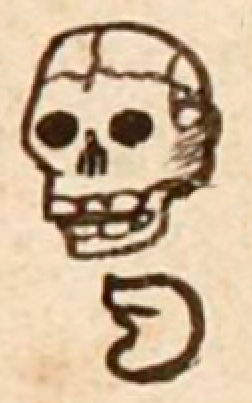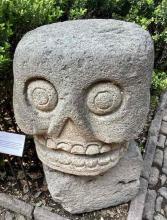Temic (Verg6r)
This black-line drawing of the compound glyph for the personal name Temic (probably meaning "Dream" here) is attested as a man’s name in this case. It shows a profile view of some human lips (tentli) and a 3/4 view of a human skull (representing a deceased person, micqui). These two elements may well be phonetic indicators for the word temictli, a dream. The skull has some shading on its left cheek bone. Its eye sockets are black holes, as is the mouth cavity, but there are teeth showing in the mouth.
Stephanie Wood
Temictli could mean "caterpillar" or "dream." This phonetic compound could refer to either. At least three other glyphs in this collection show caterpillars instead of this kind of combination, and the caterpillars resemble shrouded corpses, which could be a phonetic indication for micqui (deceased person), and provide the "mic-" element in this name. Perhaps the caterpillars were meant to disguise the meaning of "dream." Bartolomé de Alva's confessionary shows that Nahuas were interrogated about their belief in dreams. Another consideration is that the caterpillar was a dream of a butterfly to come, and butterflies figure prominently in Nahua religious beliefs, as explained in an article by Ian Mursell in Mexicolore.
Stephanie Wood
antonio.temic
Antonio Temic
Stephanie Wood
1539
Jeff Haskett-Wood
death, muerte, muertos, gente, sueños, dreams, nombres de hombres, hueso, huesos
This stone sculpture of a cranium, seemingly representing death (miquiztli), shows a frontal view something like the hieroglyph above, with upper and lower teeth and big eyes or eye sockets. The museum signage says that this carving of a skull was an architectural element, most likely from a temple or other important building. Photo by Rebecca Horn, 13 August 2023, in the Museo de Escultura Mexica at the archaeological site of Santa Cecelia Acatitlan in the area of Tlalnepantla, Mexico City.

temic(tli), a dream or a caterpillar, https://nahuatl.wired-humanities.org/content/temictli
micqui, corpse, https://nahuatl.wired-humanities.org/content/micqui
ten(tli), lip(s), https://nahuatl.wired-humanities.org/content/tentli
Codex Vergara, folio 6r, https://gallica.bnf.fr/ark:/12148/btv1b84528032/f19.item
The non-commercial reuse of images from the Bibliothèque nationale de France is free as long as the user is in compliance with the legislation in force and provides the citation: “Source gallica.bnf.fr / Bibliothèque nationale de France” or “Source gallica.bnf.fr / BnF.” We would also appreciate a citation to the Visual Lexicon of Aztec Hieroglyphs, https://aztecglyphs.wired-humanities.org/.






